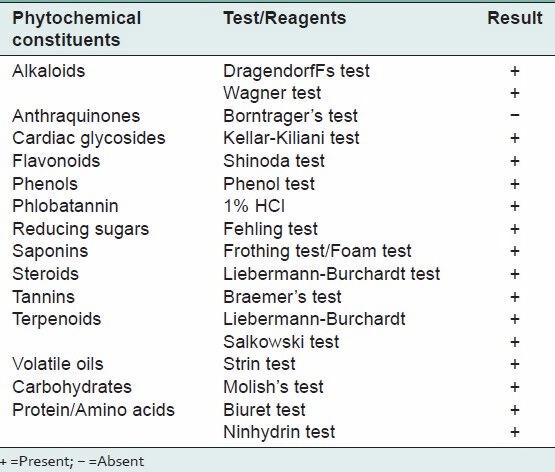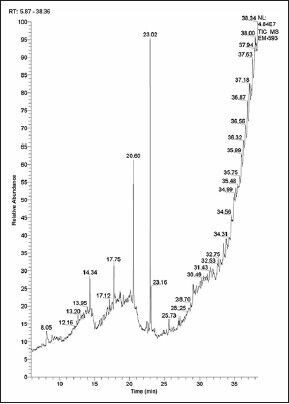Abstract
Background:
The presence of phytochemical constitutes has been reported from species of the Compositae (Asteraceae). Hitherto no reports exist on the phytochemical components and biological activity of Lactuca runcinata DC.
Objective:
The present study was designed to determine the bioactive compounds in the whole plant methanol extract of Lactuca runcinata.
Materials and Methods:
Phytochemical screening of the entire herb of Lactuca runcinata DC revealed the presence of some bio-active components. Gas chromatography-mass spectrometry (GC-MS) analysis of the whole plant methanol extract of Lactuca runcinata was performed on a GC-MS equipment (Thermo Scientific Co.) Thermo GC-TRACE ultra ver.: 5.0, Thermo MS DSQ II.
Results:
The phytochemical tests showed the presence of alkaloids, cardiac glycosides, flavonoids, phenols, phlobatannin, reducing sugars, saponins, steroids, tannins, terpenoids, volatile oils, carbohydrates, and protein/amino acids in methanolic extract of L. runcinata. The GC-MS analysis has shown the presence of different phytochemical compounds in the methanolic extract of Lactuca runcinata. A total of 21 compounds were identified representing 84.49% of total methanolic extract composition.
Conclusion:
From the results, it is evident that Lactuca runcinata contains various phytocomponents and is recommended as a plant of phytopharmaceutical importance.
Keywords: GC-MS analysis, Lactuca runcinata, phytochemical screening, whole plant methanol extract
INTRODUCTION
Use of plants as a source of medicine has been inherited and is an important component of the health care system. India is the largest producer of medicinal herbs and is appropriately called the botanical garden of the world.[1] Plants used for traditional medicine contain a wide range of substances that can be used to treat chronic as well as infectious diseases.[2] Lactuca runcinata DC [L. runcinata, Synonym-Lactuca heyneana DC.] commonly known as Undirachakam[3] or Atheli is an annual erect herb belonging to the family Compositae (Asteraceae). Traditionally this plant finds its wide applicability as diuretic and in chronic obstruction of liver and bowel.[3] Lactuca runcinata DC also has been reported to be a valuable source of essential nutrients, such as carbohydrate, protein, fat etc., and micro-nutrients like calcium, iron, phosphorous etc., Chewing Lactuca runcinata with betel leaf is useful to cure the blisters of mouth and tongue.
In the last few years, gas chromatography mass spectrometry (GC-MS) has become firmly established as a key technological platform for secondary metabolite profiling in both plant and non-plant species.[4,5,6] A detailed literature review on the plant in investigation has shown that so far there are no published reports worldwide, related to the possible chemical components of "Lactuca runcinata". So, the present study was aimed to investigate the possible chemical components by first preparing the methanolic extract and separation and identification of the compounds by subjecting it to GC-MS analysis.
MATERIALS AND METHODS
Collection of plant material
The entire herb of Lactuca runcinata DC plant (healthy and disease free plant samples) was collected from the nearby area of Thoothukudi District fields (Tamil Nadu) in December 2011, identified and authenticated by Dr. V. Chelladurai (Retired Research Officer-Botany, Central Council for Research in Ayurveda and Sidda, Govt. of India), Tiruneveli, Tamil Nadu, India. Herberium of the plant, Lactuca runcinata, was prepared and preserved in the Department of Pharmacognosy, Koringa College of Pharmacy, Korangi, East Godavari District, Andhra Pradesh, India.
Preparation of extracts
A portion of dried aerial parts (100 g) of Lactuca runcinata DC was placed in a soxhlet apparatus. Extraction was performed with 750 ml of methanol for 48 h at a temperature not exceeding the boiling point of the solvent. Extract was filtered through a 45 μm filter.[7] The resulting solution was concentrated in vacuum to dryness to give methanol extract (9 g). The extract was stored in a refrigerator at 4°C for further use.
Preliminary phytochemical screening
The methanol extract was tested for alkaloids, anthroquinones, flavonoids, phenols, steroids, tannins, terpenoids,[8] cardiac glycosides, saponins,[9] phlobatannin,[10] reducing sugars,[11] volatile oils,[12] carbohydrates and protein/amino acids.[13,14]
GC-MS (Gas Chromatography-Mass Spectrometry) analysis
The phytochemical investigation of methanolic extract was performed on a GC-MS equipment (Thermo Scientific Co.) Thermo GC-TRACE ultra ver.: 5.0, Thermo MS DSQ II. Experimental conditions of GC-MS system were as follows: TR 5-MS capillary standard non-polar column, dimension: 30Mts, ID: 0.25 mm, Film thickness: 0.25μm. Flow rate of mobile phase (carrier gas: He) was set at 1.0 ml/min. In the gas chromatography part, temperature programme (oven temperature) was 40°C raised to 250°C at 5°C/min and injection volume was 1 μl. Samples dissolved in chloroform were run fully at a range of 50-650 m/z and the results were compared by using Wiley Spectral library search programme.
RESULTS AND DISCUSSION
After the successful conventional hot soxhlet extraction of the whole part of the plant in investigation, the preliminary phytochemical study revealed that methanolic extract of Lactuca runcinata contains alkaloids, cardiac glycosides, flavonoids, phenols, phlobatannin, reducing sugars, saponins, steroids, tannins, terpenoids, volatile oils, carbohydrates, and protein/amino acids. Anthraquinones were absent in the L. runcinata methanolic extract, as summarized in [Table 1].
Table 1.
Preliminary phytochemical evaluation of methanol extracts of Lactuca runcinata

The results pertaining to GC-MS analysis of the methanolic extract of Lactuca runcinata DC lead to the identification of a number of compounds. These compounds were identified through mass spectrometry attached with GC. The various components present in the entire herb of Lactuca runcinata DC that were detected by the GC-MS are shown in [Table 2]. Carbetapentane, 2-Propenoic acid, 2-methylpropyl ester, Bornyl Acetate, Anti (9, 10)-tricyclo [4.2.1.1 (2, 5)] dec-3-en-9-endo-ol, Methanone (1-hydroxycyclohexyl) phenyl, 1 (3H)-Isobenzofuranone, 3-ethoxy, 4-Hydroxy-6-(4-methoxyphenyl)-2-pyranone, 1-Benzoyl-3-(4’- nitrophenyl) pyrrolo 21-a] phthalazine, Pyridine-3-carboxamide, 2,4,6-trichloro-N-(4-methoxyphenyl)- 5-nitro, Ethyl1-benzyl-4,6-dibromo-3-methyl-2-oxoindoline- 3-carboxylate, 5à-Cholestan-19-oic acid, 2à- hydroxy-, acetate, (5α) Pregnane-3,20α-diol, 14à,18à-[4-methyl-3-oxo-(1-oxa-4-azabutane-1,4-diyl)]-, diacetate, O, O-Diethyl (1 formylpentyl) selenophosphate, 3-n-Pentadecyl-2,4-dinitrophenol, 1,3-Bis (4-nitrobenzyl)-5,6 dihydrobenzo[f] quinazoline, 1,2-Benzenedicarboxylic acid, bis (2-ethylhexyl) ester, Dibenzoxazabicycloundecane, 4-[p-Bis (2-hydroxyethyl) amino] phenyl-1-bromoisoquinoline, Ergost-25-ene-3,6-dione, 5,12-dihydroxy-, (5à,12α), Lup-20 (29)-en-3-ol, acetate, (3α)-, E-Ethyl (Z)-3-(4- Acetylphenylthio) cinnamate were present in the methanolic extracts of Lactuca runcinata. The composition determined for this methanolic extract corresponds to 86.63% of the entire GC-MS chromatogram.
Table 2.
Compounds identified in the methanolic extract of Lactuca runcinata In GC-MS

The GC-MS spectrum confirmed the presence of various components with different retention times as illustrated in [Figure 1]. The mass spectrometer analyzes the compounds eluted at different times to identify the nature and structure of the compounds. The large compound fragments into small compounds giving rise to appearance of peaks at different m/z ratios. These mass spectra are fingerprint of that compound which can be identified from the data library.
Figure 1.

GC-MS chromatogram of methanolic extract of Lactuca runcinata
The present study helps to predict the formula and structure of 21 biomolecules. Further investigation may lead to isolation of bio-active compounds and their structural elucidation and screening of pharmacological activity will be helpful for further drug development.
CONCLUSION
The presence of various bio-active compounds detected after GC-MS analysis using the methanolic extract of Lactuca runcinata DC justifies the use of whole plant for various elements by traditional practitioner.
However, isolation of individual phytochemical constituents and subjecting it to the biological activity will be definitely giving fruitful results and will open a new area of investigation of individual components and their pharmacological potency. From these results, it could be concluded that "Lactuca runcinata" contains various bio-active compounds. Evaluation of pharmacological activity is under progress. Therefore, it is recommended as a plant of phytopharmaceutical importance.
ACKNOWLEDGEMENT
The authors are thankful to the Management of Koringa college of pharmacy, Korangi, Andhra Pradesh, India for availing all the facilities and are also thankful to Radiant Research Services Pvt. Ltd, Srinagar, Bangalore - 560 050, India for carrying out GC-MS analysis of the sample.
Footnotes
Source of Support: Nil
Conflict of Interest: None declared.
REFERENCES
- 1.Ahmedull M, Nayar MP. Red data book for Indian plants, Botanical Survey of India. vol. 4. Calcutta: 1999. [Google Scholar]
- 2.Duraipandiyan V, Ayyanar M, Ignacimuthu S. Antimicrobial activity of some ethnomedicinalplants used by Paliyar tribe from Tamil Nadu, India. BMC Complement Altern Med. 2006;6:35–41. doi: 10.1186/1472-6882-6-35. [DOI] [PMC free article] [PubMed] [Google Scholar]
- 3.Khare CP. Indian Medicinal Plants. Springer; 2008. p. 357. [Google Scholar]
- 4.Robertson DG. Metabonomics in toxicology: A review. Toxicol Sci. 2005;85:809–22. doi: 10.1093/toxsci/kfi102. [DOI] [PubMed] [Google Scholar]
- 5.Fernie AR, Trethewey RN, Krotzky AJ, Willmitzer L. Metabolite profiling: From diagnostics to systems biology. Nat Rev Mol Cell Biol. 2004;5:763–9. doi: 10.1038/nrm1451. [DOI] [PubMed] [Google Scholar]
- 6.Kell DB, Brown M, Davey HM, Dunn WB, Spasic I, Oliver SG. Metabolic footprinting and systems biology: The medium is the message. Nat Rev Microbiol. 2005;3:557–65. doi: 10.1038/nrmicro1177. [DOI] [PubMed] [Google Scholar]
- 7.Hsouna AB, Trigui M, Mansour RB, Jarraya RM, Damak M, Jaoua S. Chemical composition, cytotoxicity effect and antimicrobial activity of ceratonia siliqua essential oil with preservative effects against Listeria inoculated in minced beef meat. Int J Food Microbiol, 2011;148:66–72. doi: 10.1016/j.ijfoodmicro.2011.04.028. [DOI] [PubMed] [Google Scholar]
- 8.Kumar GS, Jayaveera KN, Kumar CK, Sanjay UP, Swamy BM, Kumar DV. Antimicrobial effects of Indian medicinal plants against acne-inducing bacteria. Trop J Pharm Res. 2007;6:717–23. [Google Scholar]
- 9.Parekh J, Chanda SV. In vitro antimicrobial activity and phytochemical analysis of some Indian medicinal plants. Turk J Biol. 2007;31:53–8. [Google Scholar]
- 10.Edeoga HO, Okwu DE, Mbaebie BO. Phytochemical constituents of some Nigerian medicinal plants. Afr J Biotechnol. 2005;4:685–8. [Google Scholar]
- 11.Akinyemi KO, Oladapo O, Okwara CE, Ibe CC, Fasure KA. Screening of crude extracts of six medicinal plants used in South-West Nigerian unorthodox medicine for anti-methicilin resistant Staphylococcus aureus activity. BMC Complement Altern Med. 2005;5:6. doi: 10.1186/1472-6882-5-6. [DOI] [PMC free article] [PubMed] [Google Scholar]
- 12.Dahiru D, Onubiyi JA, Umaru HA. Phytochemical screening and antiulcerogenic effect of Mornigo oleifera aqueous leaf extract. African Journal of Traditional, Complementary and Alternative Medicines. 2006;3:70–5. [Google Scholar]
- 13.Harborne JB. Phytochemical Methods. 2nd ed. New York, London: Springer, Chapman and Hall; 1984. p. 288. [Google Scholar]
- 14.Wagner H, Baldt S, Zgainski EM. Plant Drug Analysis. Berlin/New York: Springer Verlag; 1984. [Google Scholar]


